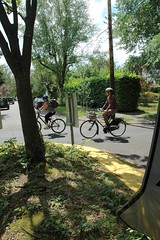How does the the built environment influence bicycling behavior? What routes do cyclists take? Will cyclists go out of their way to use bike lanes and other bike-specific infrastructure?
Those are the questions Portland State University professor Jennifer Dill has set out to answer. Dill — who teaches at PSU’s Center for Transportation Studies — embarked on a bicycling behavior research study back in January and last week she began to share some of her initial findings.
To learn more about where (and why) people ride, Dill attached at GPS unit on the bikes of 164 Portlanders for seven days. The participants logged over 1500 total bike trips. The GPS device recorded the purpose of each trip and Dill followed-up with an online survey to fill in missing gaps of information.
The research is ongoing, but Dill has already presented early findings of the study at a Congressional briefing in Washington D.C. and at a seminar at PSU last week.

Download it here (PDF)
Dill was asked by the Robert Wood Johnson Foundation (they funded the research) to speak at a briefing in front of members of Congress sponsored by the Congressional Bike Caucus as part of their recognition of Bike to Work Week. In her statement to that group (which she shared with me), Dill made the case that bike-specific infrastructure is essential if “bicycling for everyday travel can be a viable option in large cities.”
According to Dill, one of the primary reasons for Portland’s success in getting people to go by bike was that our bikeway network grew 250% between 1991 and 2007. Before 1991, she says, the number of Portlanders who regularly rode a bicycle was under 1%. Now that number is somewhere between 4 and 6.5% citywide (depending on what source you use).
Also, during that same period of bikeway construction, the number of people riding bicycles over our four main downtown bridges increased over 400%.
In Washington D.C., Dill told lawmakers that it’s time to go beyond bike lanes;
“Achieving high rates of bicycling for transportation requires a broad range of infrastructure. Bike lanes, the common focus of many cities’ efforts, are just one part of what’s necessary to significantly increase bicycling as a transportation mode. Other facility types, including off-street paths and bicycle boulevards, provide an environment that may be particularly important in attracting new cyclists.”
Dill’s research shows that half of the bicycle trips took place on roads with bike lanes, off-street paths, or that were designated bicycle boulevards. However, she also points out that those facilities represent only about 15% of the infrastructure available to cyclists in the Portland
She also found that about one out of every ten miles biked was on a bike boulevard, event though those streets make up one percent or less of the infrastructure. Similarly, while one out of seven miles biked was on an off-street path; these make up only about two percent of the infrastructure available to cyclists.
That means people vastly favor routes with bike-specific infrastructure, or streets that have been specifically engineered to prioritize bike traffic.
Here are some other interesting tidbits from Dill’s findings:
- The average trip speed was around 10mph. This is the same speed PDOT estimated when calculating times-to-destination on their bicycle boulevard signs.
- Only 6% of participants reported that they rode purely for exercise. 32% listed “home” and 26% listed “work” as the reason for their trip.
- The median bike trip length was three miles compared to 4.1 miles for work trips.
- “Infrequent” riders use minor streets more than “frequent” riders (38% to 31% respectively). On the other hand, infrequent riders use bike boulevards less. This might point to the need for stronger education and outreach about where bike boulevards are.
- 32% of all trips included another adult (55% of trips made by women).
For more on Jennifer Dill’s bicycling behavior study, an mp3 file and the presentation slides from her recent seminar at PSU are available here.



